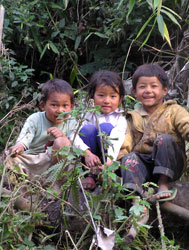Project members
- Sabine Stoll
- Elena Lieven (Department of Psychology)
- Kristina Kuhn
- Nicole Lorenz
- Netra P. Paudyal
- Claudia Polkau
- Sebastian Sauppe
- Diana Schackow
- Sarah Schneider
- Jenny Seeg
- Kodjo Vissiennon
- Kristin Wolter
Comparison of the communicative environment of young language-learning children in two cultures

The communicative environments in which children grow up differ considerably across cultures. However, there are hardly any quantitative studies of the input children receive in non-western, rural societies. The goal of this project was to quantitatively assess and compare the communicative contexts of children growing up in two very diverse cultures, namely rural Nepal (Chintang) and rural Germany.

This was an interdisciplinary project between the Department of Linguistics (Sabine Stoll) and the Department of Psychology (Elena Lieven) in which we studied the role of the communicative context for language acquisition. There are several ethnographic studies that report large variations in the communicative environments in which children grow up. These studies suggest that children growing up in cultures other than those of urban, technological societies may receive a very different language input. One such feature of this input is that children are surrounded by many more interlocutors than children in the urban settings of technological societies, and that other children of various ages are much more prominent as interlocutors . Thus, the input is less restricted to one or a very few persons as it is often the case for the early language development of children growing up in urban technological societies. So far, studies of non-urban contexts of language acquisition have focused on qualitative analyses but there are no quantitative assessments of these differences. Since we do know, however, for the technological cultures so far studied, that the amount and type of input strongly influences the rate and course of acquisition, it is important to learn more about the quantitative differences in input in different societies. In the present study, we compared the communicative and language input of 6 children in Eastern Nepal, learning Chintang, a Sino-Tibetan language, with 6 age- and gender-matched German children. Both groups of children grow up in rural areas. We coded video tapes of the children’s natural interaction for the following features: number of utterances addressed to the child, number of different people interacting with the child, kinds of interaction with the child, imitations of and by the child, interactive activities, pointings, etc.